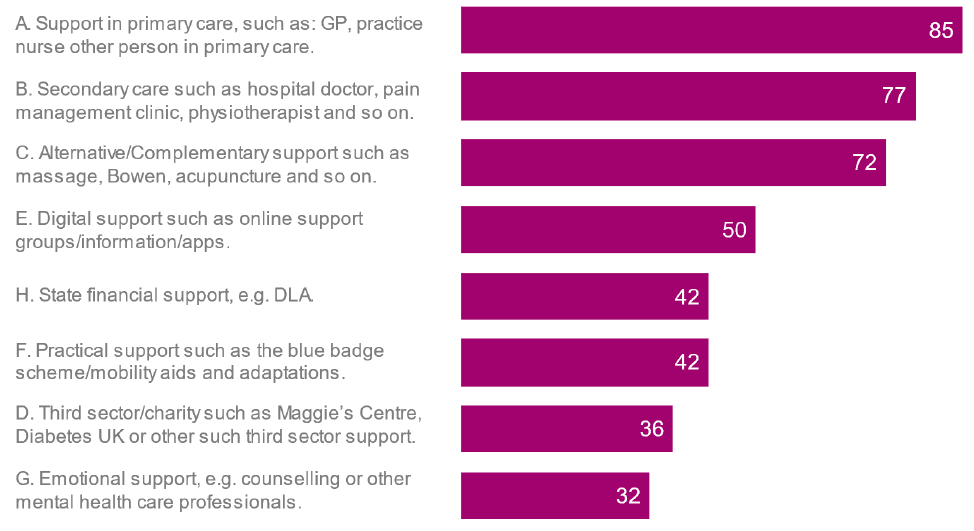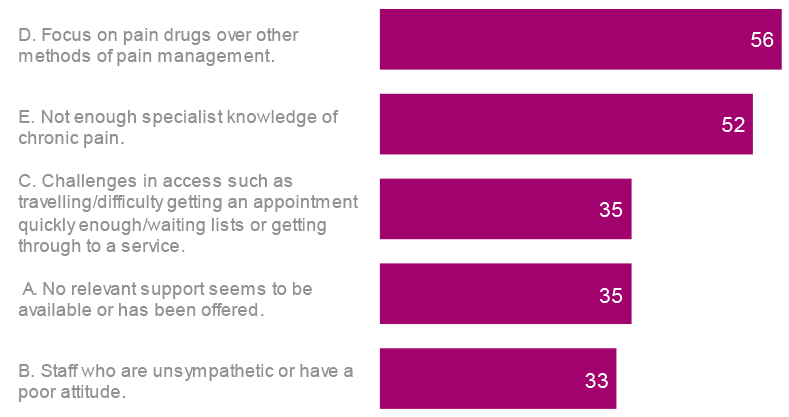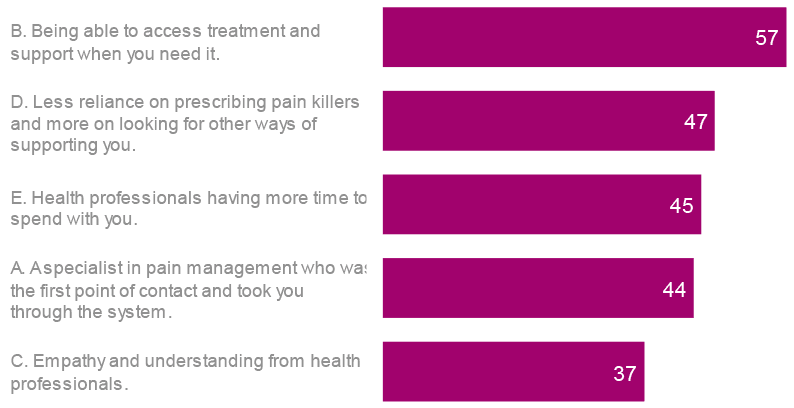Pain Management Panel consultations: report
An independently produced report of consultations with the Scottish Government Pain Management Panel between August and September 2022. The membership consists of people with lived experience of chronic pain and will help shape the planning and delivery of our Framework for Pain Management Service
Quantitative findings from the second phase of Delphi engagement
Building on the emerging findings from open discussion with panel members, the second stage of the Delphi process was delivered. This involved presenting the panel with themes from the first round of consultation and asking them to reach a consensus or prioritise the key themes using a scoring system. The exercise covered four key questions:
- What has been the most useful support that you have received up to now?
- What have been your biggest challenges or barriers to accessing support?
- What has helped you feel more in control of chronic pain?
- What is important for effective delivery of person-centred care?
Useful support
Panellists were presented with the eight forms of support identified in the open discussion and asked to rate them from the most to least useful.
A score of 8 was assigned to the support rated as most useful, with the least useful assigned a score of 1. The highest score that any one form of support could achieve would be 128, if all 16 panellists rated the same support as the most important.
Figure 3 shows the total score recorded for each type of support, out a total potential score of 128. Support in primary care was rated the most useful with a score of 85. This was followed by secondary care with a score of 77, and alternative or complementary support with a score of 72. The remaining five forms of support (digital, finance, practical, third sector or emotional support) were broadly considered less useful, scoring 50 or less.

Further analysis of the scores was carried out to better understand the breadth of ratings for each form of support (see Figure A1 in Annex A). For example, support in primary care achieved the highest total score because seven of the 16 panellists rated it as most useful, with a further three rating it as second most useful, highlighting the importance of this approach. Secondary care was rated as most useful by four panellists and second most useful by three. Two panellists rated alternative or complementary or state financial support as most important. Though no panellists rated digital support as most useful, the combination of other panellists’ ratings gave it the fourth highest total score.
Challenges or barriers to accessing support
Panellists were presented with five challenges or barriers to accessing support for chronic pain and asked to rank them from the most to least challenging.
In this exercise, the barrier rated as most challenging was assigned a score of 5, with the least challenging assigned a score of 1. The highest score that any barrier could achieve would be 80, if all 16 panellists rated the same barrier as the most challenging.
The total score recorded by each barrier is shown in Figure 4. Panellists considered focusing on pain drugs over other pain management methods the biggest barrier, scoring 56 out of 80. Only slightly behind this was a concern that there is not enough specialist knowledge of chronic pain which recorded a score of 52. The three other barriers included in this exercise recorded similar scores of 33 to 35.

The breakdown of panellists’ ratings (see Figure A2 in Annex A) reiterates the prevalence of concerns about the focus on drugs over other pain management methods, and lack of specialist knowledge. Ten of the 16 panellists rated a focus on pain drugs as the biggest or second most significant barrier to accessing support, while six panellists rated lack of specialist knowledge as the biggest or second most significant barrier.
Controlling chronic pain
Panellists were presented with five approaches that may have helped them feel more in control of chronic pain and asked to rate them in order of most helpful to least helpful. A maximum score of 80 was possible. The total scores are shown in Figure 5.
Flexible ways to engage with GPs was rated as the most helpful approach to help people feel more in control of chronic pain, recording a score of 51 out of 80. This was closely followed by a score of 45 for having a health care professional who has engaged with an individual’s concerns and taken a holistic approach.
A score of 39 was recorded for exercise classes or social support and for information about available help. Confidence and self-advocacy to negotiate services was considered the least helpful, recording a score of 24 out of 80.
Reflecting the relatively similar scores recorded for four of the five approaches, the distribution of respondent ratings across the approaches is more mixed than in the previous two exercises, as shown in Figure A3 in Annex A. Half of panellists – eight out of 16 – rated flexible ways to engage GPs as the most or second most helpful approach. While having an engaged healthcare professional recorded the second highest total score, it was rated as most useful by the largest number of panellists – five out of 16.
Views on confidence and self-advocacy were polarised, with four panellists rating this as most or second most helpful, and six rating it as least helpful.
Delivery of person-centred care
In the final exercise, panellists were shown five elements of effective delivery of person-centred care. These were ranked from most important to least important, with a maximum score of 80 possibly being assigned to each approach. The total scores are shown in Figure 9.

Accessing treatment and support when needed was rated as most important, recording a total score of 57 out of 80. Similar scores were recorded for the next three approaches, with the lowers score of 37 being recorded for the importance of empathy and understanding from health professionals.
The breakdown of panellist ratings shown is shown in Annex A (Figure A4). It reiterates the importance placed on being able to access treatment and support when it is needed; six panellists rated this as most important, with a further three rating it as second most important. By comparison, each of the other approaches were rated as most important by three panellists.
Reflecting the similar total scores, seven of the 16 panellists rated each of the next three approaches as most or second most important. This highlights the breadth of preferences evident across the panel.
Views on the importance of empathy and understanding from health professionals were more negative than positive. While six panellists rated this as most or second most important, eight rated this approach as least or second least important.
Contact
Email: Clinical_Priorities@gov.scot
There is a problem
Thanks for your feedback